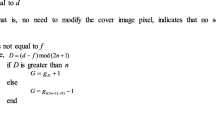Abstract
In this paper we propose a data hiding method that utilizes image interpolation and an edge detection algorithm. Image interpolation algorithm enlarges a cover image before hiding secret data in order to embed a large amount of secret data. Edge detection algorithm is applied to improve a quality of stego-image. Experimental results show that the proposed method can embed a large amount of secret data while keeping visual quality better than previous works. We demonstrate that the average capacity is 391,115bits, and the PSNR and quality index are 44.71dB, 0.9568 for gray images when threshold value is 4 and the embedding bits are given to 2 respectively.






Similar content being viewed by others
References
Awrangjeb M (2003) An overview of reversible data hiding. In: ICCIT, pp 75–79
Canny JF (1986) A computational approach to edge detection. IEEE Trans Pattern Anal Mach Intell 8(6):679–698
Celik MU, Sharman G, Tekalp AM, Saber E (2002) Reversible data hiding. In: Proceedings of IEEE 2002 international conference on image processing, vol 2, pp 157–160
Chan CK, Cheng LM (2004) Hiding data in images by simple LSB substitution. Pattern Recogn 37:469–474
Chang CC, Chen TS, Lin Y (2000) An efficient edge detection scheme of color image. In: Proceedings of the Fifth Joint Conference on Information Science, pp 448–455
Chang CC, Lin MH, Hu YC (2002) A fast and secure image hiding scheme based on LSB substitution. Int J Pattern Recogn 16(4):399–416
Chen TS, Chang CC, Hwang MS (1998) A virtual image cryptosystem based upon vector quantization. IEEE Trans Image Process 7:1485–1488
Chen WJ, Chang CC, Le THN (2010) High payload steganography mechanism using hybrid edge detector. Expert Syst Appl 37:3292–3301
Danielsson PE, Hammerin M (1992) Note: high accuracy rotation of images. In: CVGIP: graph. Models image processing, vol 54, no 4, pp 340–344
Davis LS (1975) A survey of edge detection techniques. Comput Vis Graph Image Process 248–270
De Vleeschouwer C, Delaigle JF, Macq B (2001) Circular interpretation on histogram for reversible watermarking. In: IEEE IMSP workshop, pp 345–350
Delcroix CJ, Abidi MA (1988) Fusion of edge maps in color images. Proc SPIE Int Soc Opt Eng 1001:545–554
Evans OD, Kim Y (1998) Efficient implementation of image warping on a multimedia processor. Real-Time Imaging 4:417–428
Fridrich J, Goljan M, Du R (2001) Invertible authentication. In: Proc. SPIE, security and watemarking of multimedia contents, pp 197–208
Geman D (1987) Stochastic model for boundary detection. Image Vis Comput 5(2):61–65
Goljan M, Fredrich J, Du R (2001) Distortion-free data embedding. In: Proceedings of 4th information hiding workshop, pp 27–41
Gonzalez RC, Woods RE (2008) Digital Image Processing, 3rd edn. Prentice Hall, Englewood Cliffs
Honsinger CW, Jones P, Rabbani M, Stoffel JC (2001) Lossless recovery of an original image containing embedded data. US Patent:6,278,791 B1
Hou HS, Andrews HC (1987) Cubic splines for image interpolation and digital filtering. In: IEEE trans. acoust., speech, signal processing, vol ASSP-26, no 6, pp 508–517
Hsiao JY, Chan KF, Chang JM (2009) Block-based reversible data embedding. Signal Process 89:556–569
Johnson NF, Jajodia S (1998) Exploring steganography: seeing the unseen. Computer 31(2):26–34
Keys RG (1981) Cubic convolution interpolation for digital image processing. In: IEEE trans. acoust., speech, signal processing, vol ASSP-29, no 6, pp 1153–1160
Lee CC, Wu HC, Tsai CS, Chu YP (2008) Adaptive lossless steganographic scheme with centralized difference expansion. Pattern Recogn 41:2097–2106
Lehmann TM, Gonner C, Spitzer K (1999) Survey: interpolation methods in medical image processing. IEEE Trans Med Imag 18(11):1049–1075
Macq B, Dewhyand F (1999) Trusted Headers for Medical Images, DFG VIII-D II Watermarking Workshop. Erlangen, Germany
Maeland E (1988) On the comparison of interpolation methods. IEEE Trans Med Imag 7(3):213–217
Nevatia R (1977) A color edge detection and its use in scene segmentation. IEEE Trans Syst Man Cybern 7:802–826
Ni Z, Shi YQ, Ansari N, Su W (2006) Reversible data hiding. IEEE Trans Circuits Syst Video Technol 16:354–362
Parker JA, Kenyon RV, Troxel DE (1983) Comparison of interpolating methods for image re-sampling. IEEE Trans Med Imag MI-2:31–39
Pei SC, Cheng CM (1999) Color image processing by using binary quaternion-moment-preserving thresholding technique. IEEE Trans Image Process 8(5):614–628
Rowland SW (1979) Computer implementation of image reconstruction formulas. In: Herman GT (ed) Image reconstruction from projections: implementation and applications. Springer, Berlin, pp 9–70
Schultz RR, Stevenson RL (1994) A bayesian approach to image expansion for improved definition. IEEE Trans Image Process 3(3):233–242
Swanson M, Kobayashi M, Tewfik A (1998) Multimedia data embedding and watermarking technologies. Proc IEEE 86(6):1064–1087
Tai WL, Yeh CM, Chang CC (2009) Reversible data hiding based on histogram modification of pixel differences. IEEE Trans Circuits Syst Video Technol 19:906–910
Thien CC, Lin JC (2003) A simple and high-hiding capacity method for hiding digit-by-digit data in images based on modulus function. Pattern Recogn 36:2876–2881
Thurnhofer S, Mitra S (1996) Edge-enhanced image zooming. Opt Eng 35(7):1862–1870
Tsai P, Chang CC, Hu YC (1985) An adaptive two-stage edge detection scheme for digital color images. Real-Time Imaging 8(4):329–343
Unser M, Aldroubi A, Eden M (1991) Fast b-splines transforms for continuous image representation and interpolation. IEEE Trans Pattern Anal Mach Intell 13:277–285
Unser M, Thevenaz P, Yaroslavsky L (1995) Convolution-based interpolation for fast, high-quality rotation of images. IEEE Trans Image Process 4:1371–1381
Wang RZ, Lin CF, Lin JC (2001) Image hiding by optimal LSB substitution and genetic algorithm. Pattern Recogn 34(3):671–683
Wang Z, Bovik AC (2002) A universal image quality index. IEEE Signal Process Lett 9:81–84
Xuan G, Zhu J, Chen J, Shi YQ, Ni Z, Su W (2002) Distortionless data hiding based on integer wavelet transform. IEEE Lett 38(25):1646–1648
Yang CK, Tsai WH (1996) Reduction of color space dimensionality by moment-preserving thresholding and its application for edge detection in color image. Pattern Recogn Lett 17(5):481–490
Zenzo SD (1986) A note on the gradient of a multi-image. Comput Vis Graph Image Process 33(1):116–128
Author information
Authors and Affiliations
Corresponding author
Rights and permissions
About this article
Cite this article
Jung, KH., Yoo, KY. Data hiding using edge detector for scalable images. Multimed Tools Appl 71, 1455–1468 (2014). https://doi.org/10.1007/s11042-012-1293-8
Published:
Issue Date:
DOI: https://doi.org/10.1007/s11042-012-1293-8




